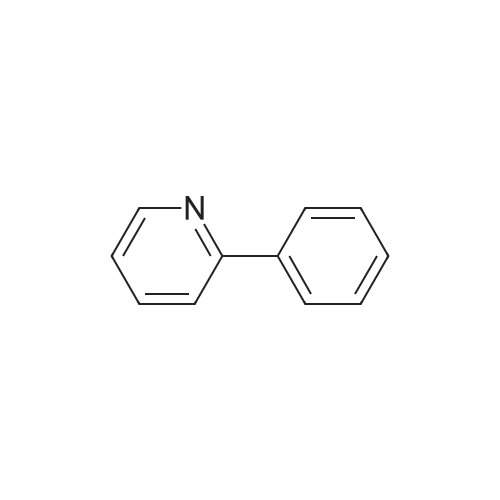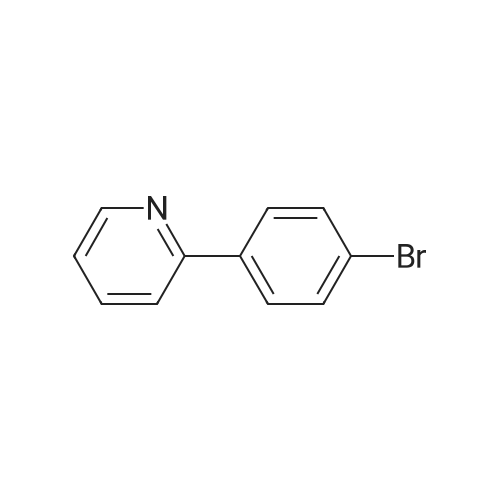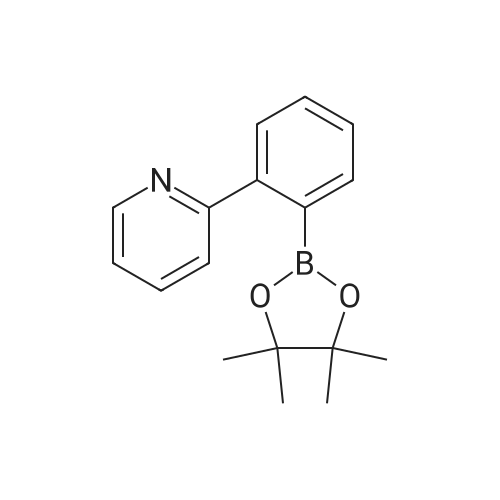| 92% |
With phosphoric acid; In water; glycerol; at 200 - 210℃; for 10h;Heating / reflux;Product distribution / selectivity; |
In a three-necked flask equipped with a reflux condenser was placed 100 ml of glycerin and the flask was swept free of air by blowing N2 for 3.5 hours. Thereafter, 2.0 g of iridium(III) acetylacetonate, 7.5 g of 2-phenylpyridine, and 5.9 g of phosphoric acid (85percent aqueous solution) were added and, in a nitrogen atmosphere, the mixture was heated under reflux in an oil bath at a bath temperature of 200-210°C with stirring for 10 hours. Upon completion of the reaction, the mixture was cooled to room temperature, 30 ml of ethanol and 300 ml of 2N HCl were added, the mixture was stirred, and the precipitate was filtered. The precipitate was transferred to a beaker, washed with 50 ml of ethanol with stirring, and filtered again. The precipitate thus obtained was transferred to a 100-ml eggplant-shaped flask, 60 ml of acetonitrile was added, and the mixture was heated in an oil bath at a bath temperature of 100°C for 1 hour. The mixture was cooled to room temperature and the precipitate was filtered, washed with 30 ml of acetonitrile and 30 ml of ethanol, and dried under reduced pressure at 80°C for 5 hours to give 2.4 g of yellow crystals. An MS analysis identified the yellow crystal as ortho-metalated iridium complex (2): yield, 92percent; purity by HPLC, 99percent; MS (ESI-TOFMS), 655. |
| 68 - 85% |
With tartaric acid; In glycerol; at 200 - 210℃; for 5 - 44h;Heating / reflux;Product distribution / selectivity; |
In a three-necked flask equipped with a reflux condenser was placed 100 ml of glycerin and the flask was swept free of air by blowing N2 for 3.5 hours. Thereafter, 2.0 g of iridium(III) acetylacetonate, 7.5 g of 2-phenylpyridine, and 3.3 g of tartaric acid were added and, in a nitrogen atmosphere, the mixture was heated under reflux in an oil bath at a bath temperature of 200-210°C with stirring for 10 hours. Upon completion of the reaction, the mixture was cooled to room temperature, 30 ml of ethanol and 300 ml of 2N HCl were added, the mixture was stirred, and the precipitate was filtered. The precipitate was transferred to a beaker, washed with 50 ml of ethanol with stirring, and filtered again. The precipitate thus obtained was transferred to a 100-ml eggplant-shaped flask, 60 ml of acetonitrile was added, and the mixture was heated with stirring in an oil bath at a bath temperature of 100°C for 1 hour. The mixture was cooled to room temperature and the precipitate was filtered, washed with 30 ml of acetonitrile and 30 ml of ethanol, and dried under reduced pressure at 80°C for 5 hours to give 1.8 g of yellow crystals. An MS analysis identified the yellow crystal as tris(2-phenylpyridine)iridium(III) or ortho-metalated iridium complex (2) represented by chemical formula (2): yield, 68percent; purity by HPLC, 99percent; MS (ESI-TOFMS), 655.; Example 2; In a three-necked flask equipped with a reflux condenser was placed 100 ml of glycerin and the flask was swept free of air by blowing N2 for 3.5 hours. Thereafter, 2.0 g of iridium(III) acetylacetonate, 7.5 g of 2-phenylpyridine, and 3.3 g of tartaric acid were added and, in a nitrogen atmosphere, the mixture was heated under reflux in an oil bath at a bath temperature of 200-210°C with stirring for 44 hours. Upon completion of the reaction, the mixture was cooled to room temperature, 30 ml of ethanol and 300 ml of 2N HCl were added, the mixture was stirred, and the precipitate was filtered. The precipitate was transferred to a beaker, washed with 50 ml of ethanol with stirring, and filtered again. The precipitate thus obtained was transferred to a 100-ml eggplant-shaped flask, 60 ml of acetonitrile was added, and the mixture was heated with stirring in an oil bath at a bath temperature of 100°C for 1 hour. The mixture was cooled to room temperature and the precipitate was filtered, washed with 30 ml of acetonitrile and 30 ml of ethanol, and dried under reduced pressure at 80°C for 5 hours to give 2.2 g of yellow crystals. An MS analysis identified the yellow crystal as ortho-metalated iridium complex (2): yield, 83percent; purity by HPLC, 99percent; MS (ESI-TOFMS), 655; .Example 3; In a three-necked flask equipped with a reflux condenser was placed 100 ml of glycerin and the flask was swept free of air by blowing with N2 for 3.5 hours. Thereafter, 2.0 g of iridium(III) acetylacetonate, 7.5 g of 2-phenylpyridine, and 9 g of tartaric acid were added and, in a nitrogen atmosphere, the mixture was heated under reflux in an oil bath at a bath temperature of 200-210°C with stirring for 5 hours. Upon completion of the reaction, the mixture was cooled to room temperature, 30 ml of ethanol and 300 ml of 2N HCl were added, the mixture was stirred, and the precipitate was filtered. The precipitate was transferred to a beaker, washed with 50 ml of ethanol with stirring, and filtered again. The precipitate thus obtained was transferred to a 100-ml eggplant-shaped flask, 60 ml of acetonitrile was added, and the mixture was heated in an oil bath at a bath temperature of 100°C for 1 hour. The mixture was cooled to room temperature and the precipitate was filtered, washed with 30 ml of acetonitrile and 30 ml of ethanol, and dried under reduced pressure at 80°C for 5 hours to give 1.8 g of yellow crystals. An MS analysis identified the yellow crystal as ortho-metalated iridium complex (2): yield, 70percent; purity by HPLC, 99percent; MS (ESI-TOFMS), 655.; Example 4; In a three-necked flask equipped with a reflux condenser was placed 100 ml of glycerin and the flask was swept free of air by blowing N2 for 3.5 hours. Thereafter, 2.0 g of iridium(III) acetylacetonate, 7.5 g of 2-phenylpyridine, and 9 g of tartaric acid were added and, in a nitrogen atmosphere, the mixture was heated under reflux in an oil bath at a bath temperature of 200-210°C with stirring for 10 hours. Upon completion of the reaction, the mixture was cooled to room temperature, 30 ml of ethanol and 300 ml of 2N HCl were added, the mixture was stirred, and the precipitate was filtered. The precipitate was transferred to a beaker, washed with 50 ml of ethanol with stirring, and filtered again. The precipitate thus obtained was transferred to a 100-ml eggplant-shaped flask, 60 ml of acetonitrile was added, and the mixture was heated in an oil bath at a bath temperature of 100°C for 1 hour. The mixture was cooled to room temperature and the precipitate was filtered, washed with 30 ml of acetonitrile and 30 ml ... |

 Chemistry
Chemistry
 Pharmaceutical Intermediates
Pharmaceutical Intermediates
 Inhibitors/Agonists
Inhibitors/Agonists
 Material Science
Material Science















 For Research Only
For Research Only
 120K+ Compounds
120K+ Compounds
 Competitive Price
Competitive Price
 1-2 Day Shipping
1-2 Day Shipping












